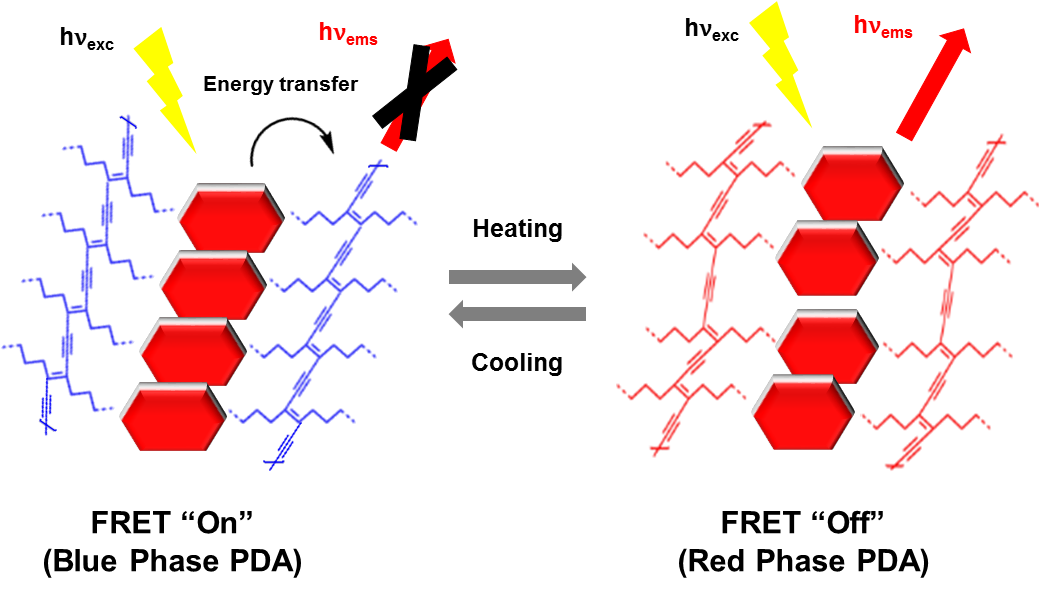Covalently Linked Perylene Diimide–Polydiacetylene Nanofibers Display Enhanced Stability and Photocurrent with Reversible FRET Phenomenon
| author | Sungnam Park |
|---|---|
| Homepage | https://ultrafastspec.wixsite.com/spark |
| journal | Small, 2019, 15, 1901342 |
Because of their unique structural and optical properties, 1D perylene diimide (PDI) derivatives have gained attention for use in optoelectronic devices. However, PDI‐containing self‐assembled supramolecular systems often are of limited use because they have supramolecular architectures that are held together by weak noncovalent π–π stacking, hydrogen bonding, and hydrophobic interactions. As a result, they are intrinsically unstable under solution‐processing conditions. To overcome this limitation, a polydiacetylene (PDA)‐based strategy is developed to construct a solvent‐resistant and stable PDI assembly. For this purpose, first the monomer PDI–BisDA is generated, in which two polymerizable diacetylene (DA) units are covalently linked to a PDI core. Importantly, 254 nm UV irradiation of self‐assembled PDI–BisDA nanofibers forms solvent‐resistant and stable PDI–PDA fibers. Owing to the presence of PDA, the generated polymer fibers display an increased photocurrent. In addition, the existence of PDA and PDI moieties in the fiber leads to the occurrence of switchable on–off fluorescence resonance energy transfer (FRET) between the PDI and reversibly thermochromic PDA chromophores.

« Prev Conjugated Polyelectrolytes as Multifunctional Passivating an...
 Conjugated Polyelectrolytes as Multifunctional Passivating an...
2019.06.07by webmaster
〈
Conjugated Polyelectrolytes as Multifunctional Passivating an...
2019.06.07by webmaster
〈
Blue Emission of α-GaN Colloidal Quantum Dots via Zn Doping Next »
 Blue Emission of α-GaN Colloidal Quantum Dots via Zn Doping
2019.05.27by webmaster
〉
Blue Emission of α-GaN Colloidal Quantum Dots via Zn Doping
2019.05.27by webmaster
〉
Articles
-
 Significantly Improved Morphology and Efficiency of Nonhalogenated Solvent-Proces...
Significantly Improved Morphology and Efficiency of Nonhalogenated Solvent-Proces...
-
 Mechanical Force Induces Ylide-Free Cycloaddition of Nonscissible Aziridines
Mechanical Force Induces Ylide-Free Cycloaddition of Nonscissible Aziridines
-
 Bright ligand-activatable fluorescent protein for high-quality multicolor live-ce...
Bright ligand-activatable fluorescent protein for high-quality multicolor live-ce...
-
 Mid-wavelength Infrared Photoluminescence and Lasing of Tellurium Element Solid a...
Mid-wavelength Infrared Photoluminescence and Lasing of Tellurium Element Solid a...
-
 Power Factor of One Molecule Thick Films and Length Dependence
Power Factor of One Molecule Thick Films and Length Dependence
-
 An Emerging Molecular Design Approach to Heavy-Atom-Free Photosensitizers for Enh...
An Emerging Molecular Design Approach to Heavy-Atom-Free Photosensitizers for Enh...
-
 Ga‐Based Liquid Metal Micro/Nanoparticles: Recent Advances and Applications
Ga‐Based Liquid Metal Micro/Nanoparticles: Recent Advances and Applications
-
 A Hydrogen-Bonded Organic Framework with Type IV NH3 Adsorption Behavior
A Hydrogen-Bonded Organic Framework with Type IV NH3 Adsorption Behavior
-
 Janus to Core-Shell to Janus: Facile Cation Movement in Cu2-xS/Ag2S Hexagonal Nan...
Janus to Core-Shell to Janus: Facile Cation Movement in Cu2-xS/Ag2S Hexagonal Nan...
-
 Two Different Length-Dependent Regimes in Thermoelectric Large-Area Junctions of ...
Two Different Length-Dependent Regimes in Thermoelectric Large-Area Junctions of ...
-
 From p-Xylene to Ibuprofen in Flow: 3-Step Synthesis via Unified Sequence of Chem...
From p-Xylene to Ibuprofen in Flow: 3-Step Synthesis via Unified Sequence of Chem...
-
 Mid-wavelength Infrared Photoluminescence and Lasing of Tellurium Element Solid a...
Mid-wavelength Infrared Photoluminescence and Lasing of Tellurium Element Solid a...
-
 Structure–thermopower relationships in molecular thermoelectrics
Structure–thermopower relationships in molecular thermoelectrics
-
 Cytoplasmic Protein Imaging with Mid-Infrared Photothermal Microscopy: Cellular D...
Cytoplasmic Protein Imaging with Mid-Infrared Photothermal Microscopy: Cellular D...
-
 Conjugated Polyelectrolytes as Multifunctional Passivating and Hole‐Transporting ...
Conjugated Polyelectrolytes as Multifunctional Passivating and Hole‐Transporting ...
-
 Covalently Linked Perylene Diimide–Polydiacetylene Nanofibers Display Enhanced St...
Covalently Linked Perylene Diimide–Polydiacetylene Nanofibers Display Enhanced St...
-
 Blue Emission of α-GaN Colloidal Quantum Dots via Zn Doping
Blue Emission of α-GaN Colloidal Quantum Dots via Zn Doping
-
 Gas‐phase conformations of intrinsically disordered proteins and their complexes ...
Gas‐phase conformations of intrinsically disordered proteins and their complexes ...
-
 Multifunctional Self-Doped Nanocrystal Thin-Film Transistor Sensors
Multifunctional Self-Doped Nanocrystal Thin-Film Transistor Sensors
-
 Fine-tuning of wettability in a single metal–organic framework via postcoordinati...
Fine-tuning of wettability in a single metal–organic framework via postcoordinati...
Designed by sketchbooks.co.kr / sketchbook5 board skin